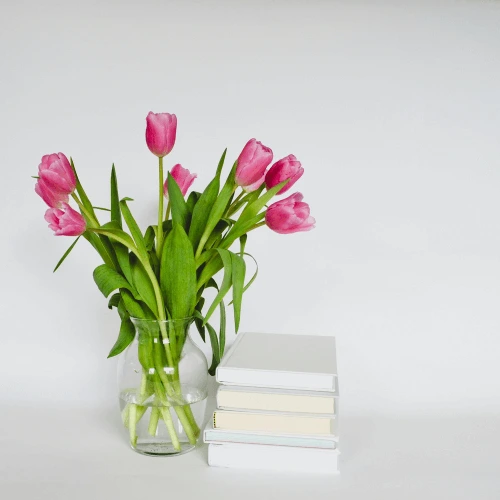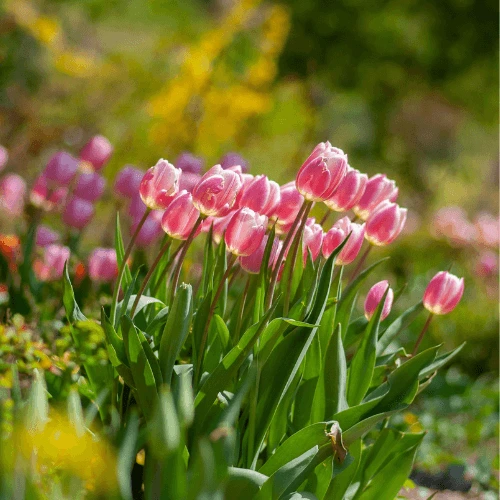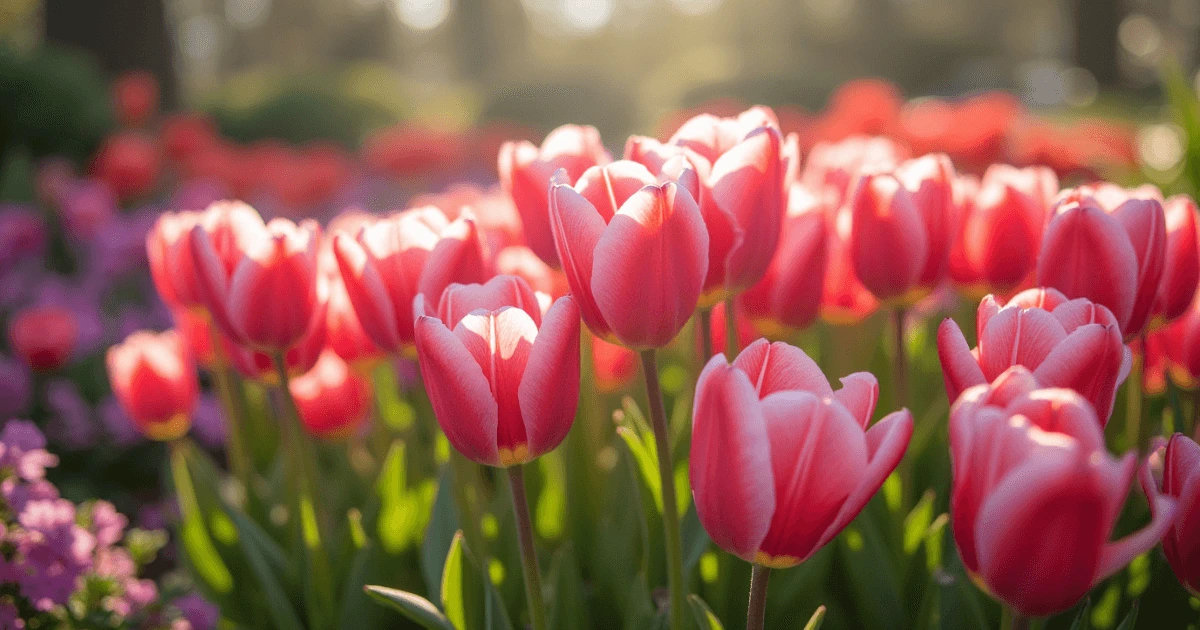Have you ever dreamed of a garden bursting with vibrant blooms, where every flower tells its own story? Pink tulips are not just beautiful flowers—they embody affection, care, and joy, making them an ideal choice for any garden. Whether you’re a seasoned gardener or planting your very first bulbs, this guide is here to help you bring these stunning flowers to life.
Why choose pink tulips? Not only do they brighten up any space, but they’re also surprisingly easy to grow, even for beginners. From selecting the best bulbs to creating breathtaking garden designs, you’ll learn everything you need to know.
Are you excited to get your hands dirty and begin planting? Let’s dive in and make your dream of a pink tulip garden a reality!
In This Article
| Common Name | Pink Tulips |
| Botanical Name | Tulipa spp. |
| Family | Liliaceae |
| Plant Type | Perennial (grown as an annual in some climates) |
| Mature Size | 10–24 inches tall, depending on the variety |
| Bloom Time | Spring (early to late, depending on variety) |
| Toxicity | Toxic to pets (e.g., dogs and cats) and humans if ingested in large amounts |
| Sun Exposure | Full sun (6+ hours of direct sunlight daily) |
| Soil Type | Well-draining soil, enriched with organic matter |
| Soil pH | Neutral to slightly acidic (6.0–7.0) |
| Flower Color | Shades of pink (from pale blush to vibrant magenta) |
| Hardiness Zones | USDA zones 3–8 |
| Native Area | Central Asia |
Understanding Pink Tulips: A Beginner’s Delight
Have you ever gazed at a bed of pink tulips and felt an instant sense of calm and joy? These charming flowers aren’t just visually stunning—they also carry deep meaning and are surprisingly easy to grow, even for beginners. Whether you’re looking to add a splash of color to your garden or want a flower with a touch of symbolism, pink tulips are the perfect choice.
Why Choose Pink Tulips for Your Garden?
Pink tulips are more than just beautiful blooms. This is why they’re so beloved by gardeners:
- Aesthetic Appeal: With their soft hues ranging from pale blush to vibrant magenta, pink tulips fit effortlessly into any garden style.
- Symbolism: Did you know pink tulips symbolize affection, care, and happiness? Planting these flowers can add a thoughtful touch to your space.
- Versatility: Whether you’re designing a formal flower bed or adding color to a casual garden, pink tulips shine in every setting.
Popular Pink Tulip Varieties
As you embark on your tulip-growing journey, you’ll discover a range of pink varieties that suit your garden and climate. Here are a few beginner-friendly options:
- Angelique: Known for its peony-like blooms, this variety is ideal for creating a romantic garden vibe.
- Pink Impression: A classic choice for its large, vibrant petals that make a bold statement.
- China Pink: Delicate and graceful, this tulip variety thrives in most American gardens.
The Growth Cycle: From Bulb to Blossom
Understanding how tulips grow is key to ensuring their success. These flowers follow a simple yet fascinating cycle:
- Dormancy: The bulbs rest during the summer, preparing for fall planting.
- Growth: As temperatures drop, the bulbs begin to establish roots.
- Blooming: Come spring, you’ll be rewarded with stunning pink tulip blooms that light up your garden.
By knowing what to expect, you can plan your gardening tasks around this natural rhythm.
With their effortless beauty and heartwarming symbolism, pink tulips are a wonderful addition to any garden. Ready to take the plunge into gardening with these delightful blooms? Let’s dive deeper into how to prepare for planting!



Preparing to Plant Pink Tulips: Setting the Stage for Success
Are you ready to get your hands dirty and plant some pink tulips? Preparation is key to ensuring these delicate beauties bloom to their fullest potential. Don’t worry—it’s simpler than you think. Let’s break it down into manageable steps that even a beginner can follow.
Choosing the Right Tulip Bulbs
Your pink tulips’ success starts with selecting the right bulbs. How can you tell which ones are the best to choose?
- Size Matters: Larger bulbs tend to produce healthier, bigger flowers. Look for firm, plump bulbs that feel heavy for their size.
- Inspect for Damage: Avoid bulbs with cracks, mold, or soft spots. Healthy bulbs are your ticket to a thriving tulip garden.
- Source from Reputable Sellers: Local nurseries or online stores specializing in bulbs can offer high-quality options suited for the U.S. climate.
Investing in top-notch bulbs may cost a bit more upfront but saves you from frustration later.
The Perfect Spot for Your Pink Tulips
Tulips thrive in the right environment, and pink tulips are no exception. Choosing the best location is crucial.
- Sunlight: Tulips love basking in full sun, so pick a spot that gets at least 6 hours of direct sunlight daily.
- Well-Draining Soil: These flowers dislike sitting in waterlogged soil. Enhance drainage by incorporating organic materials such as compost or sand.
- Protection from Wind: A gentle breeze is fine, but strong winds can damage delicate blooms. Plant your tulips near a hedge or garden wall for extra protection.
Tools You’ll Need for Planting
Having the right tools can make your gardening experience enjoyable and efficient. Here’s a quick checklist:
- Bulb Planter: For digging uniform holes effortlessly.
- Trowel: Handy for smaller planting jobs.
- Gardening Gloves: Protect your hands from dirt and bulb coatings.
- Compost or Fertilizer: To enrich the soil and give your tulips a head start.
Timing is Everything
When should you plant your pink tulips? The fall months—usually September to November—are ideal. Lower temperatures allow the bulbs to develop roots before winter arrives.If you’re in the northern U.S., aim for earlier in the fall, while southern states can plant a bit later.
With the right preparation, you’re already halfway to a stunning display of pink tulips. Next, we’ll dive into the step-by-step process of planting these vibrant flowers. Stay tuned—it’s easier than you think!
Step-by-Step Guide to Planting Pink Tulips
Now that you’ve got your pink tulip bulbs and a prime garden spot ready, it’s time to get planting! This step-by-step guide will walk you through the process, ensuring your tulips get off to the best possible start. Don’t worry—it’s easier than you might think, and the results will be worth every effort.
Step 1: Timing is Everything
Planting pink tulips at the right time is essential for their success. In most parts of the U.S., fall is the ideal season. Aim for a time when the soil temperature drops to around 50°F, typically between late September and early November. This gives the bulbs enough time to develop roots before the ground freezes.
Pro Tip: Plant earlier in northern states and later in southern regions to adapt to the climate.
Step 2: Prepare the Soil
Healthy soil is the foundation of a vibrant tulip display. This is how you can prepare your soil effectively:
- Loosen the Soil: Use a garden fork or trowel to loosen the top 12 inches of soil.
- Improve Drainage: Mix in compost or sand to prevent waterlogging, which can rot the bulbs.
- Add Fertilizer: Incorporate a bulb-specific fertilizer or bone meal to give your tulips the nutrients they need.
Step 3: Digging the Holes
Depth and spacing are crucial factors when planting.
- Depth: Dig holes about 6-8 inches deep. This protects the bulbs from temperature fluctuations and pests.
- Spacing: Leave 4-6 inches between each bulb to give them room to grow.
If you’re planting in clusters, group 5-10 bulbs together for a stunning visual impact.
Step 4: Plant the Bulbs
Place each bulb into the hole, ensuring the pointed end is directed upward. This ensures the tulip shoots grow in the right direction. Gently cover the bulbs with soil, taking care not to pack it down too tightly.
Step 5: Water Them In
After planting, water the bulbs thoroughly. This aids in settling the soil and jumpstarting root development. While tulips don’t need a lot of water, keeping the soil slightly moist (not soggy) during the initial weeks is helpful.
Step 6: Mulch for Protection
To protect your bulbs during the winter, add a layer of mulch—such as straw, bark, or leaves—over the soil. This insulates the bulbs and prevents extreme temperature changes.
With these steps, you’re well on your way to enjoying a breathtaking display of pink tulips come springtime. Remember, the key to success lies in thoughtful preparation and care. Next up, we’ll explore how to keep your tulips thriving with simple maintenance tips.
Caring for Pink Tulips: Simple Steps to Keep Them Thriving
Congratulations! You’ve planted your pink tulips, and now the real fun begins—watching them grow and bloom. But how do you ensure your tulips stay healthy and vibrant throughout their life cycle? Don’t worry; caring for pink tulips is straightforward and highly rewarding. Let’s walk through the essentials.
Watering Your Pink Tulips the Right Way
Did you know overwatering is one of the most common mistakes gardeners make? Pink tulips prefer well-draining soil, so keeping moisture levels balanced is key.
- After Planting: Water the bulbs thoroughly to help them establish roots, but avoid soaking the soil.
- During Growth: Water sparingly during the spring growing season. If rain is frequent, you might not need to water at all.
- Avoid Standing Water: Always check the soil before watering—if it feels damp, hold off.
Feeding Your Pink Tulips
Just like us, tulips need nutrients to thrive. Fertilizing at the right time can make all the difference in their bloom quality.
- At Planting: Mix bulb fertilizer or bone meal into the soil to give the bulbs a head start.
- Early Spring: Once the shoots appear, apply a balanced, slow-release fertilizer to encourage healthy growth.
- Post-Bloom: Skip the fertilizer once the blooms fade, as tulips focus on storing energy for the next season.
Protecting Against Pests and Diseases
Pink tulips are hardy, but they aren’t invincible. Pests like squirrels and diseases like fungal rot can pose challenges. Here’s how to protect your plants:
- Pest Prevention: Cover your bulbs with wire mesh after planting to keep squirrels and rodents at bay. Once the tulips sprout, the critters typically lose interest.
- Fungal Protection: Avoid overwatering and ensure proper drainage to prevent fungal diseases. Treat any signs of rot with a fungicide promptly.
- Deer Deterrents: If deer are common in your area, use natural deterrents like garlic sprays or plant tulips alongside less appealing flowers.
Post-Bloom Maintenance
When your pink tulips finish blooming, it’s time to prepare them for the next cycle.
- Deadhead Spent Flowers: Remove the faded blooms to prevent the plant from diverting energy into seed production.
- Leave the Leaves: Resist the urge to cut back the foliage too soon—this is essential for photosynthesis and storing energy for the next season.
- Store Bulbs Properly: If you plan to remove the bulbs, store them in a cool, dry place until fall.
Caring for pink tulips doesn’t require a green thumb—just a little attention and love. With these simple tips, your garden will be bursting with vibrant pink blooms year after year. Up next, we’ll explore how to design your garden to showcase your tulips beautifully!
Designing a Stunning Garden with Pink Tulips
Have you ever imagined stepping into your backyard and being greeted by a breathtaking display of pink tulips? With a little planning and creativity, you can transform your garden into a vibrant masterpiece. Let’s explore some design ideas to help your tulips steal the show.
Create Eye-Catching Combinations
Pink tulips pair beautifully with a variety of other flowers and plants. Consider these combinations to add depth and interest to your garden:
- Contrasting Colors: Plant pink tulips alongside yellow daffodils or blue hyacinths for a bold and cheerful contrast.
- Soft Pastels: Pair them with lavender or white daisies for a romantic and serene vibe.
- Foliage Partners: Incorporate plants like hostas or ferns for lush greenery that complements the tulips’ vibrant blooms.
Play with Layouts
How you arrange your tulips can make a big difference in your garden’s overall look.
- Borders and Pathways: Line pink tulips along garden paths or borders for a structured yet elegant design.
- Clusters and Groups: Plant tulips in clusters of 5-10 bulbs for a more natural, meadow-like appearance.
- Layered Heights: Combine tulips with taller or shorter plants to create layers and dimension.
Seasonal Impact
For a garden that keeps wowing, consider planting pink tulips alongside perennials that bloom later in the season. This way, your garden transitions seamlessly from spring to summer.
With these design ideas, your pink tulips will become the star attraction of your outdoor space. Ready to make your garden a true work of art? Let’s bring it all together in the next section!
FAQs About Growing Pink Tulips
Got questions about growing pink tulips? You’re not alone! Here are some of the most common questions gardeners ask—and the answers you need to keep your tulips thriving.
1. When is the Best Time to Plant Pink Tulips?
The ideal time to plant pink tulips is in the fall, typically between late September and November. The soil should be cool but not frozen—around 50°F is perfect. This gives the bulbs enough time to establish roots before winter sets in, ensuring they bloom beautifully in spring.
2. How Long Do Pink Tulips Bloom?
Pink tulips usually bloom for 1-2 weeks in the spring, depending on the variety and weather conditions. To extend the blooming period, plant tulips with staggered blooming times, such as early, mid, and late-season varieties.
3. Can Pink Tulips Be Grown Indoors?
Yes, you can grow pink tulips indoors through a process called forcing. Simply chill the bulbs for 10-12 weeks in a cool, dark place, then plant them in pots and place them in a sunny spot. With proper care, they’ll bloom indoors, adding a touch of spring to your home.
4. Do Pink Tulips Need Special Care After Blooming?
After blooming, deadhead the spent flowers to prevent the plant from focusing energy on seed production. Leave the foliage intact for several weeks to allow photosynthesis, which helps the bulb store energy for the next season.
5. What Pests Commonly Affect Pink Tulips?
Squirrels, deer, and aphids are the most common culprits. To protect your tulips, use deterrents like wire mesh for bulbs, natural sprays, or companion planting with less appealing flowers.
Got more questions about pink tulips? Drop them in the comments! With the right care and attention, these blooms will bring endless beauty to your garden.
Conclusion: Your Pink Tulip Journey Awaits
As you’ve seen, growing pink tulips isn’t just about planting flowers—it’s about creating a garden filled with beauty, joy, and meaning. From understanding their charm to designing a space that lets them shine, you’re now equipped with everything you need to make your tulip dreams a reality.
So, what’s stopping you? Imagine the satisfaction of seeing those vibrant pink blooms light up your garden each spring. Whether you’re planning to plant them in neat borders, mix them with other flowers, or grow them indoors, pink tulips offer endless possibilities for creativity and inspiration.
Are you ready to get started? Your garden is waiting, and the rewards will be more than worth it. Share your pink tulip journey with us—we’d love to hear your tips, challenges, and successes. Happy planting!

